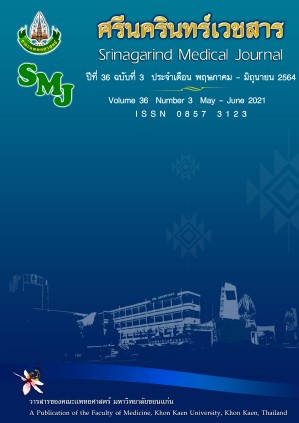ผลของไครซินต่อยาเคมีบำบัดเมโธเทรกเซทเหนี่ยวนำให้ความจำและการสร้างเซลล์ประสาทในสมองส่วนฮิปโปแคมปัสลดลงในหนูแรทโตเต็มวัย
Abstract
หลักการและเหตุผล: เมโธเทรกเซทเป็นยาเคมีบำบัดที่ใช้อย่างแพร่หลายในการรักษามะเร็งหลายชนิด มีการศึกษาพบว่าการรักษาด้วยเมโธเทรกเซทสามารถเหนี่ยวนำให้เกิดภาวะความจำบกพร่อง ไครซินเป็นสารจำพวกฟลาโวนอยด์ที่พบได้ในธรรมชาติ การศึกษาที่ผ่านมาพบว่าไครซินมีคุณสมบัติในการป้องกันการเสื่อมของระบบประสาทและฟื้นฟูความจำ ดังนั้นการศึกษาในครั้งนี้จึงมีวัตถุประสงค์เพื่อศึกษาผลของไครซินต่อความจำบกพร่องที่เกิดจากการเหนี่ยวนำด้วยเมโธเทรกเซท
วิธีการศึกษา: หนูแรท เพศผู้ สายพันธุ์ Sprague Dawley จำนวน 72 ตัว ถูกแบ่งออกเป็น 6 กลุ่ม ได้แก่ control, MTX, chrysin 10, chrysin 30, chrysin 10+MTX และ chrysin 30+MTX โดยกลุ่ม controlได้รับน้ำเกลือและโพรพิลีนไกลคอล ไครซิน (10 และ 30 มิลลิกรัม/กิโลกรัม) ให้โดยการป้อนเป็นเวลา 15 วัน เมโธเทรกเซท(75 มิลลิกรัม/กิโลกรัม) ให้โดยการฉีดเข้าหลอดเลือดดำในวันที่ 8 และ 15 ของการทดลอง หลังการสิ้นสุดการให้สาร 3 วัน น้ำหนักและการเคลื่อนไหวของหนูถูกนำมาวิเคราะห์ และความจำถูกทดสอบด้วยการทดสอบ novel object location (NOL) และ novel object recognition (NOR)
ผลการศึกษา: ข้อมูลของทุกกลุ่มพบว่า ไม่มีความแตกต่างกันอย่างมีนัยสำคัญทางสถิติของระยะเวลาในการสำรวจวัตถุ ในการทดสอบ NOL และ NOR พบว่ากลุ่ม control, chrysin 10, chrysin 30, chrysin 10+MTX และ chrysin 30+MTX สามารถจำแนกตำแหน่งและวัตถุเก่าใหม่ได้อย่างมีนัยสำคัญทางสถิติยกเว้นกลุ่ม MTX
สรุป: การศึกษาในครั้งนี้ชี้ให้เห็นว่า เมโธเทรกเซทสามารถเหนี่ยวนำให้เกิดภาวะความจำบกพร่อง ในทางตรงกันข้าม ไครซินสามารถฟื้นฟูภาวะความจำบกพร่องในหนูแรทที่ได้รับเมโธเทรกเซท
คำสำคัญ: ไครซิน; เมโธเทรกเซท; ความจำบกพร่อง
Background and objective: Methotrexate (MTX)is a chemotherapy drug that is the most widely used to protect against many malignancies. Several reports have shown that MTX can induce cognitive impairment. Chrysin is a natural flavonoid that is found in natural products. Previous studies have found that chrysin has neuroprotective and cognitive improving properties. Therefore, this study was designed to determine the protective effect of chrysin against MTX-induced memory impairments.
Methods: Seventy-two male Sprague Dawley rats were divided into 6 groups; control, MTX, chrysin 10, chrysin 30, chrysin 10+MTX and chrysin 30+MTX groups. The control group received saline and propylene glycol. Chrysin (10 and 30 mg/kg) was administered by oral gavage for 15 days. A single dose of MTX (75 mg/kg) was administered by intravenous injection on days 8 and 15. Three days after the end of drug administration, the body weight and locomotor activity were determined. The memories were evaluated using novel object location (NOL) and novel object recognition (NOR) tests.
Results: The data of all groups showed no significant differences in term of total exploration times. In both the NOL and NOR tests, the control, chrysin 10, chrysin 30, chrysin 10+MTX and chrysin 30+MTX groups could significantly discriminate between the familiar and novel location or object except the MTX group.
Conclusion: This study demonstrates that MTX induces memory impairment. In contrast, chrysin could improve memory impairment in rats received MTX.
Keywords: Chrysin; Methotrexate; Memory impairment


